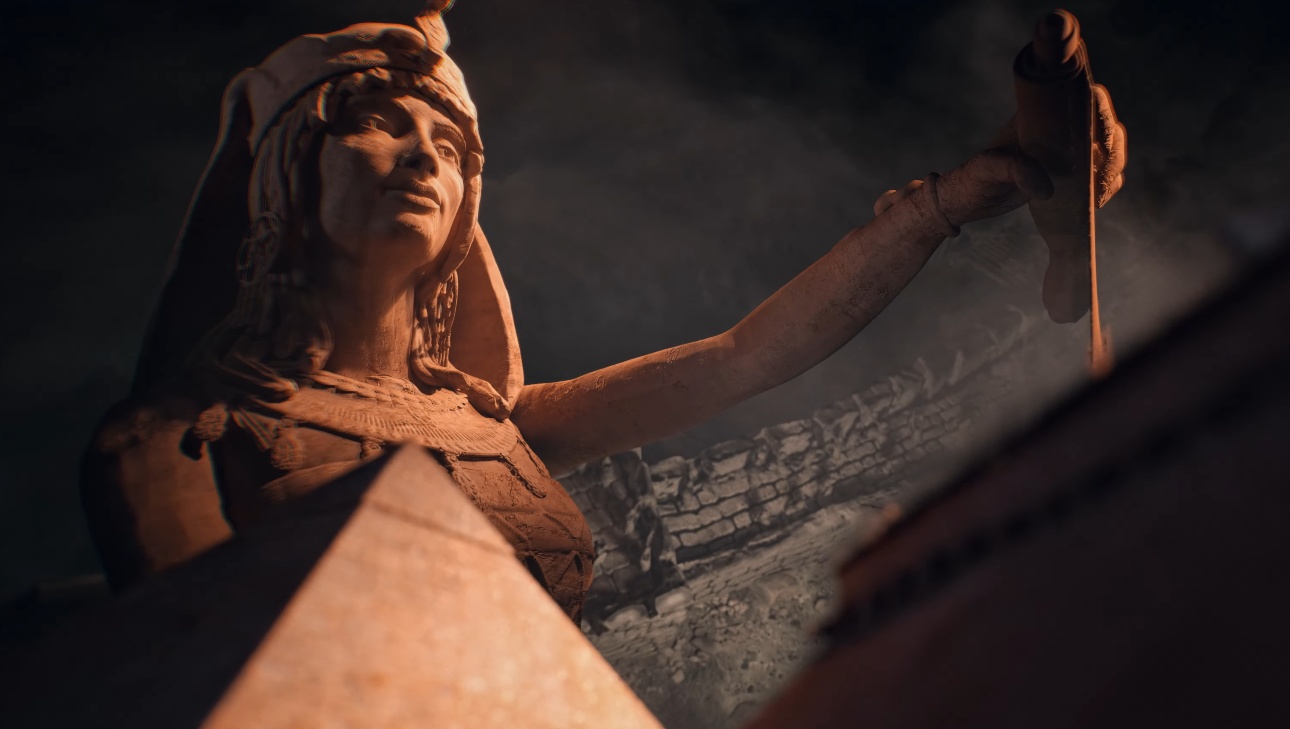In Civilization 7, unlike previous games in the series, any leader can lead any civilization. So your choice of civilization is completely independent, allowing for a huge set of possible bonuses. And while your chosen leader will follow you all the way to the end, you’ll choose a new civilization for each of the three acts: Antiquity, Exploration, and Modern.
Each civ comes with a unique ability, unique civics, at least two unique units, and one or more unique infrastructures (which is basically the new name for unique buildings). They also specialize in two of the six civ attributes (Cultural, Economic, Diplomatic, Expansionist, Militarist, and Scientific). Here are all of the civs we know about so far:
Aksum
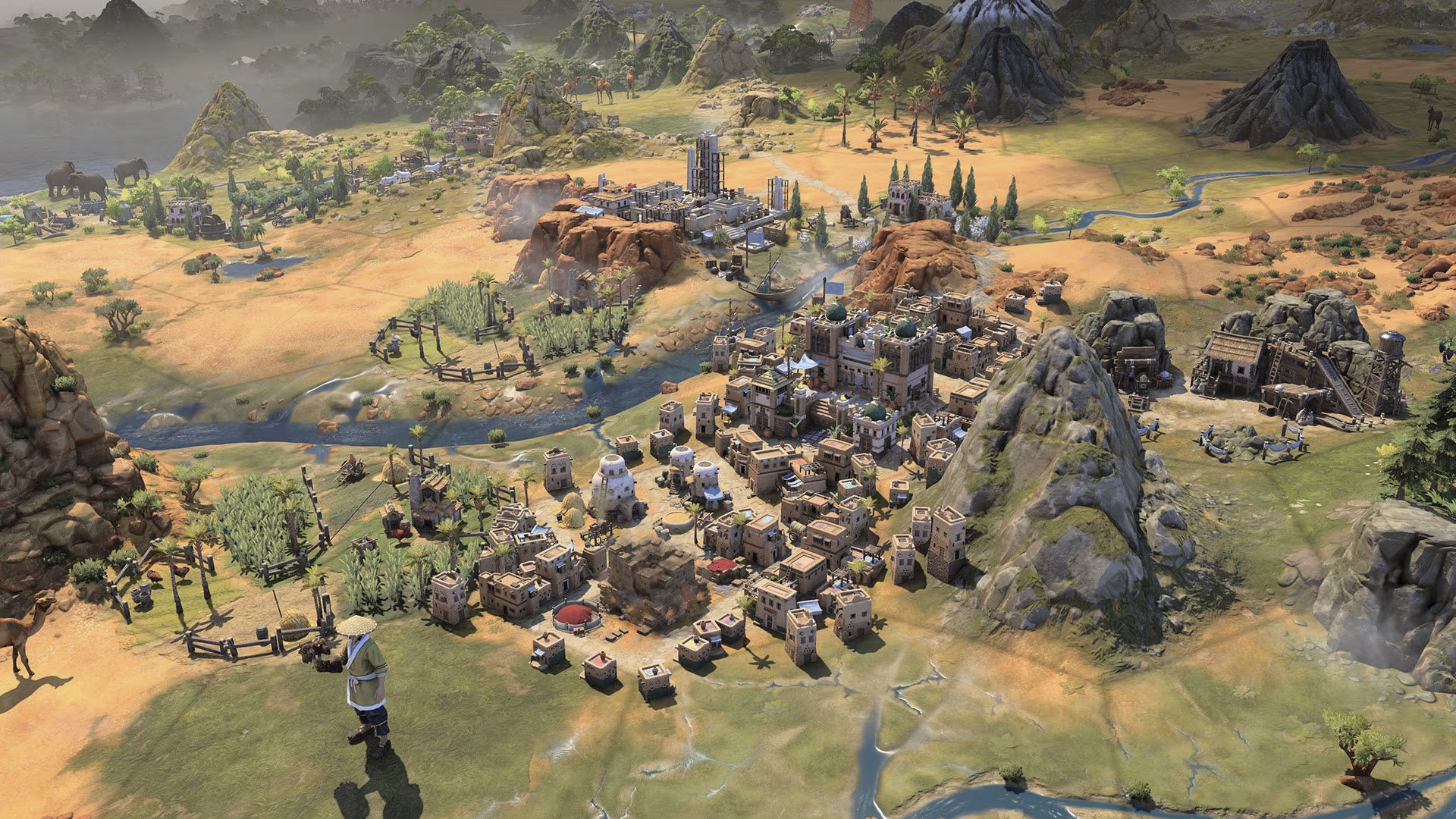
Age: Antiquity
Historical context: Founded in the 1st century CE and hitting its height around the 500s, the Aksumite Empire was based around what is now Northern Ethiopia, and was considered by some an equal to Rome and Persia.
- Attributes: Cultural, Economic
- Unique ability: Kingdom of Natural Wealth. All resources that produce Gold produce more of it.
- Unique military unit: Dhow. An early naval unit with increased strength on coasts and the ability to create a naval trade route.
- Unique civilian unit: Tankwa. A trade ship that cannot be pillaged and has increased trade route range.
- Unique improvement: Hawlit. Produces culture for each adjacent wonder, but can only be built on flat land.
Our advice: The Asksumites are poised to dominate in coastal trade, with safe shipping lanes and an advantage in coastal naval combat. Saving up some gold for later ages while your culture flourishes seems like a wise plan.
Egypt
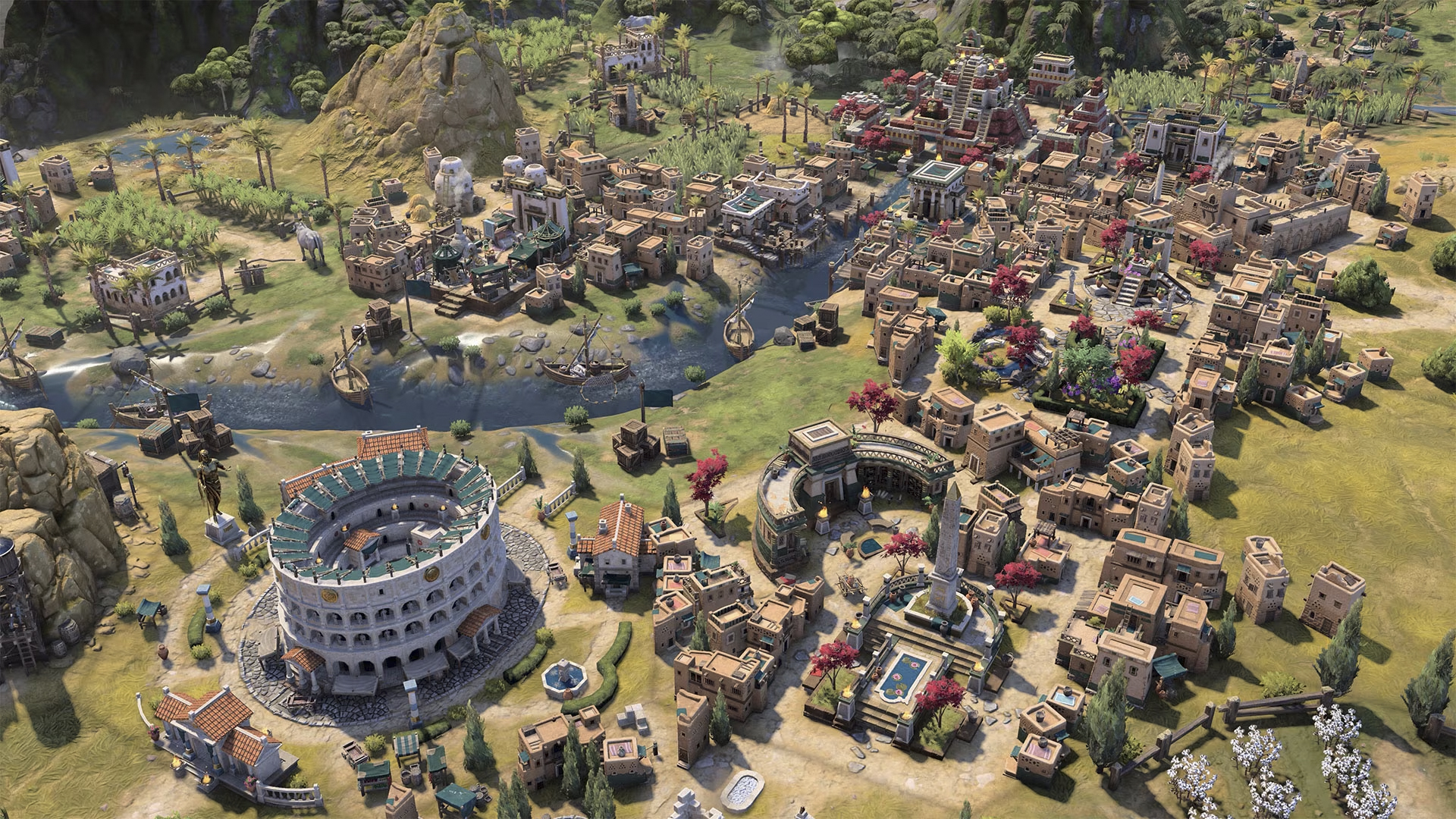
Age: Antiquity
Historical context: One of the oldest complex agricultural civilizations, they’re known today for some rather large triangles and many of the earliest depictions of furries and scalies. Fun fact: Cleopatra lived closer to the present day than to the last time you finished an entire campaign of Civ on Marathon speed.
- Attributes: Cultural, Economic
- Unique ability: Gifts of Osiris. Tiles on navigable rivers give more Production.
- Unique military unit: Medjay. Infantry with increased strength in friendly territory, and an even higher bonus for being stationed in an owned settlement.
- Unique civilian unit: Tjaty. Produced in any city with a Necropolis, granting one of several randomized historical figures with unique bonuses. It’s like if a loot box was a guy with a cool hat. Basically you’re replacing one of the standard Great Person lists (in this case the Vizier) with a unique, Egypt-specific list that is better.
- Unique quarter: Necropolis. Gain Gold every time a wonder is completed in this city.
- Unique building: Mastaba. Produces Culture, as well as bonus Gold for adjacent Desert tiles.
- Unique building: Mortuary Temple. Produces Gold, as well as bonus Happiness for adjacent navigable rivers.
Our advice: Settling near navigable rivers is obviously a must. But beyond that, Egypt is deceptively flexible, and could fit a lot of different playstyles. Even if you want to play aggressively, it may be better to let your enemies come to you first, so you can take advantage of your home turf combat bonuses.
Greece
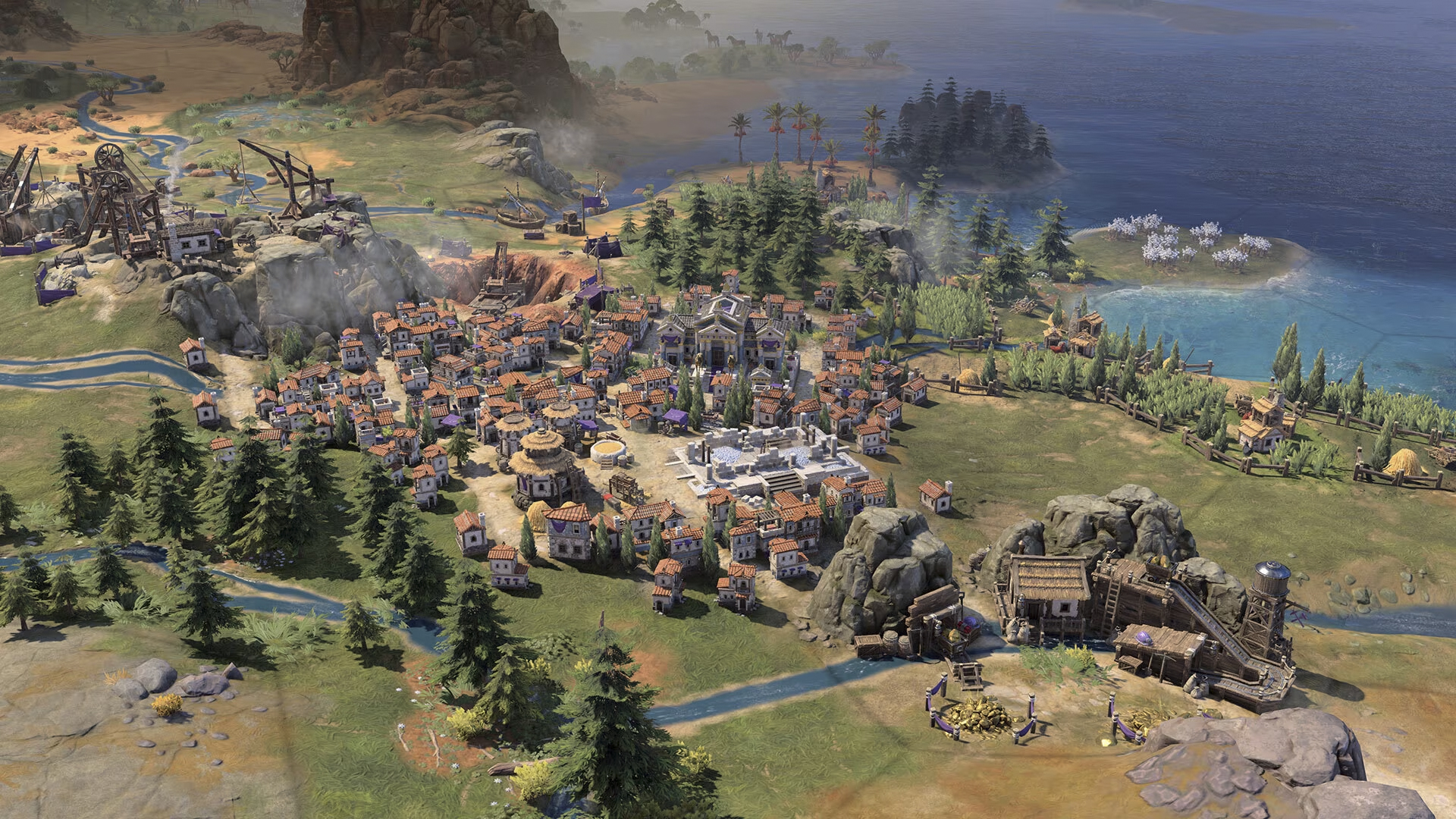
Age: Antiquity
Historical context: The starting point for the majority of national myths that seek to set everything West of the Levant as a special, cool place where all the special-est, coolest people came from, they are credited with the Olympics, Western philosophy, and some pretty damn impressive beards.
- Attributes: Cultural, Diplomatic
- Unique ability: Demokratia. Increased Influence (that’d be the new diplomatic currency in Civ 7) on Palaces.
- Unique military unit: Hoplite. Increased strength when adjacent to another Hoplite.
- Unique civilian unit: Logios. Similar to Egypt’s Tjaty, this is like a unique Great Person that can spawn as one of several randomized historical figures with different bonuses. Aristotle, Plato, Sappho—the gang’s all here. They replace the vanilla Scholar and can only be built in cities with an Acropolis.
- Unique quarter: Acropolis. For every city-state you are suzerain of, your Parthenon building produces extra Gold.
- Unique building: Parthenon. Produces Culture, as well as bonus Influence if placed on rough terrain.
- Unique building: Odeon. Produces Happiness, as well as bonus Culture for each adjacent quarter.
Our advice: The Greeks are definitely set up to master the Culture game, but you could also get some early conquest done with Hoplites if you make the most of their formidable formation fighting. Building a league of city-states should also be a major priority.
Han China
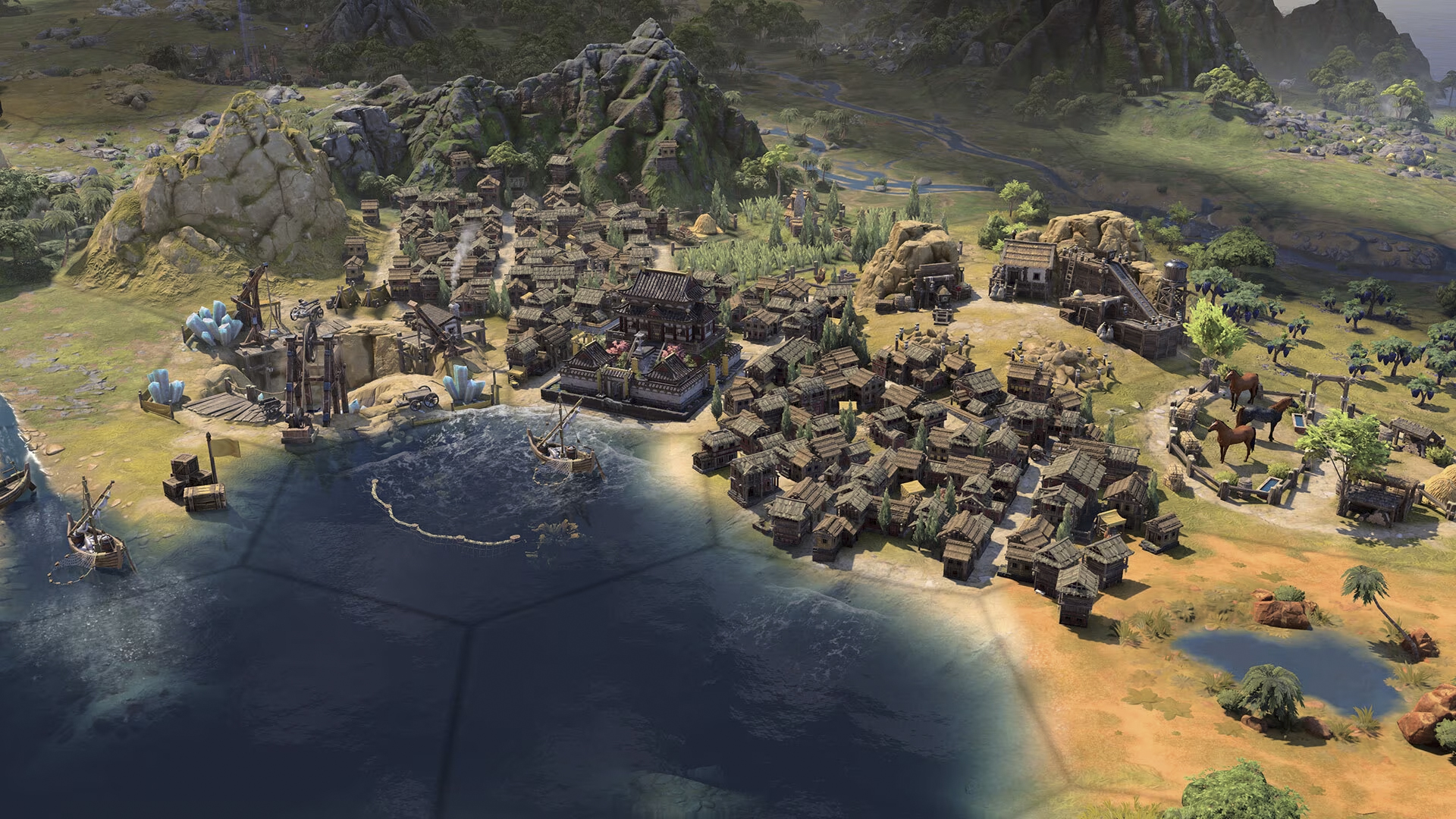
Age: Antiquity
Historical context: The Han dynasty of China reigned from the 200s BCE to the 200s CE, laying many of the foundations for later Chinese civilization and even giving their name to the Han ethnicity that most Chinese people identify with today.
- Attributes: Diplomatic, Scientific
- Unique ability: Nine Provinces. The Capital and new Towns gain two population the first time they get a growth event, instead of just one.
- Unique military unit: Chu-Ko-Nu. You’ve seen these guys, I’m sure. It’s like a repeater crossbow. They have a zone of control (which most ranged units do not) to prevent other units from simply marching right past them, and higher defense than other early archers. While they can engage from up to one tile away, they also get increased strength at point-blank range.
- Unique civilian unit: Shì Dàfū. It’s another one of those loot box guys, replacing the Scholar just like Greece’s Logios, and representing a variety of important figures in early Chinese history from Laozi to Meng Ke (known as Mencius to Western scholars).
- Unique improvement: Great Wall. We’re back to building this thing in individual segments. Each one gives Culture, as well as bonus Happiness for each adjacent Great Wall segment. Also increased combat strength for defenders on the same tile. Wall segments have to be built in a continuous line. They can eventually loop around, but they can’t branch off.
Our advice: A very defensible capital and early bonuses to population growth give you a lot of options, and as usual for a Chinese civ in Civ, they will be a natural pick for a Science-focused playstyle, albeit one that now depends a bit more on RNG.
Khmer
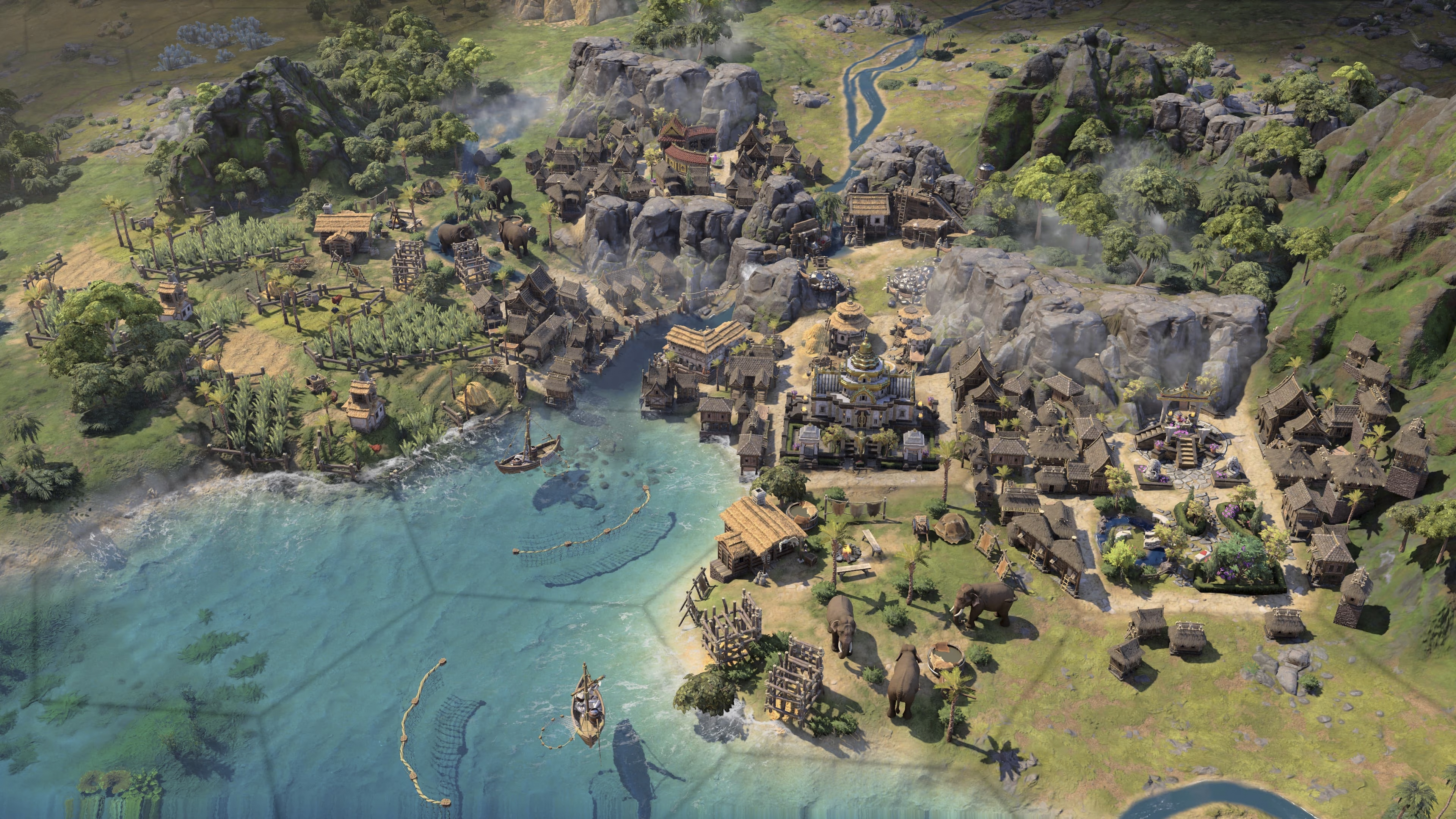
Age: Antiquity
Historical context: The Khmer Empire was founded around 800 CE, making it one of the youngest starter civs in Civ 7, centered on what is today Cambodia. They came to control most of mainland Southeast Asia at their height.
- Attributes: Expansionist, Scientific
- Unique ability: Ksekam Chamnon. Urban districts next to rivers retain the output of any natural resources they were built on top of.
- Unique military unit: Yuthahathi. A cavalry unit with increased combat strength but reduced speed. It cannot be damaged by floods.
- Unique civilian unit: Vaishya. A merchant that cannot be damaged by floods and ignores movement penalties in flooded tiles.
- Unique improvement: Baray. Produces Food, increasing based on the number of floodplains within the borders of the settlement it is built. You can only build one per settlement and it must be on flat ground.
Our advice: Natural disasters from Civ 6’s Gathering Storm expansion are getting folded into the base game in Civ 7, and the Khmer are particularly well-equipped to survive and thrive with the natural flood cycles. Boosted food production and lower opportunity costs for urbanization will allow them to pursue many different strategies.
Maurya India
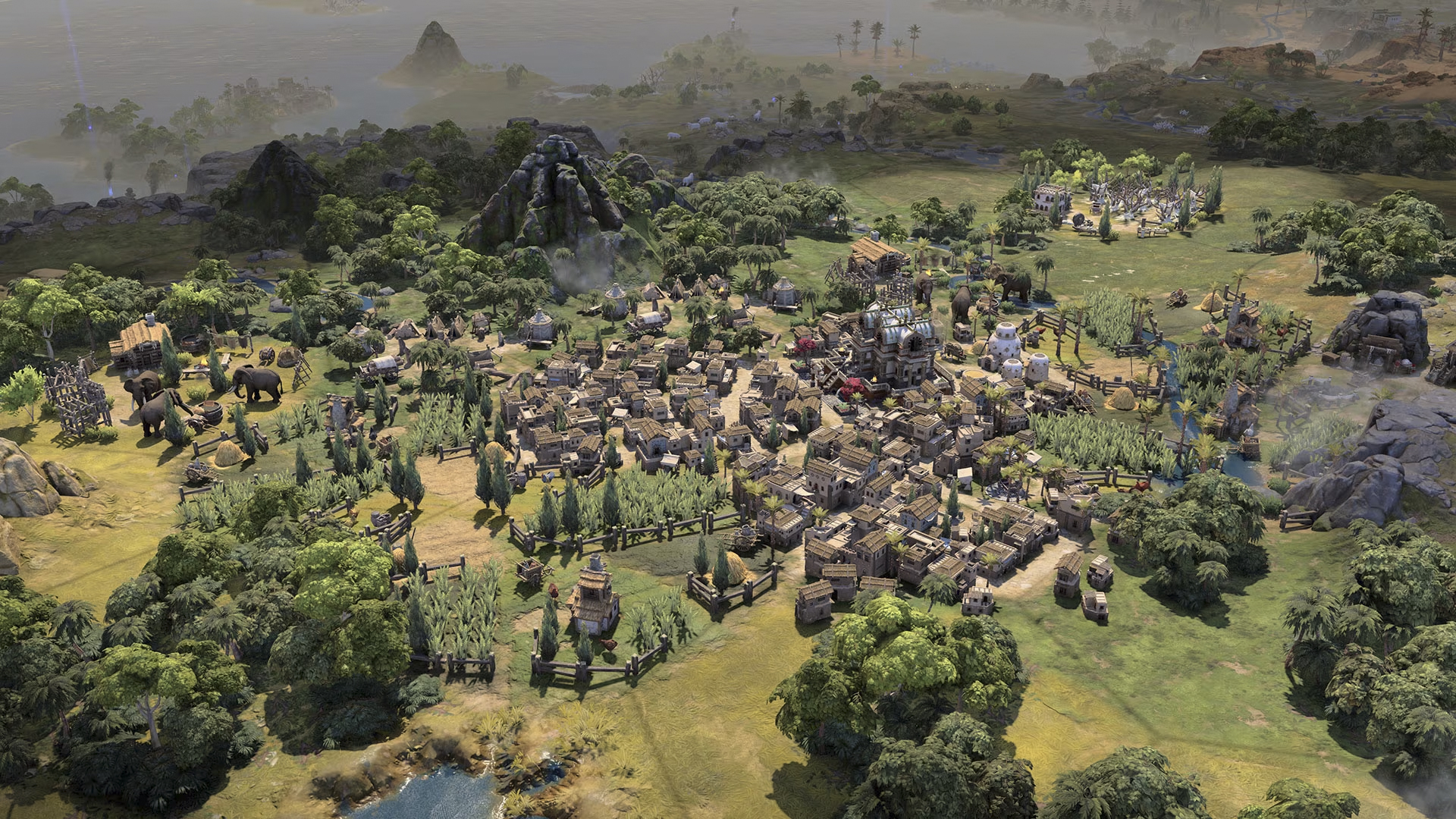
Age: Antiquity
Historical context: Founded in 322 BCE, the Maurya Empire grew to be the largest empire in South Asia up to that point. Controlling land from what is now Afghanistan all the way to the Bengal Delta, they were the cultural and political predecessors of most Indian subcontinent civilizations that came after them.
- Attributes: Militaristic, Scientific
- Unique ability: Dhamma Lipi. When you unlock Mysticism in the civics tree, you can choose an additional Pantheon bonus to represent your diverse religious beliefs.
- Unique military unit: Purabhettarah. A cavalry unit that has increased strength when fighting fortifications.
- Unique civilian unit: Nagarika. A settler that gives bonus Happiness on city halls.
- Unique quarter: Matha. Increases Happiness in the city where it is built.
- Unique building: Dharamshala. Produces Happiness, as well as bonus Science for every adjacent quarter.
- Unique building: Vihara. Produces Happiness, as well as bonus Culture for adjacent mountains.
Our advice: Indian civs tend to focus on growth in Civ, and the Maurya seem to be no exception. But rather than speeding things up with food, they provide a lot of ways to keep your population centers happy. So you might grow slower, but the maximum population you can manage is greater. They are well-equipped for conquest and aggressive settling, as well as culture and science.
Maya

Age: Antiquity
Historical context: Less of an empire than a series of related societies that existed mainly in Mexico’s Yucatan peninsula from at least 2000 BCE, they were renowned for their early discoveries in astronomy and the development of a complex writing system.
- Attributes: Diplomatic, Scientific
- Unique ability: Skies of Itzamna. Palaces produce bonus Science for every adjacent tile with vegetation.
- Unique military unit: Hul’che. A ranged unit that can see and move through tiles with vegetation as if they were open land.
- Unique civilian unit: Jaguar Slayer. A replacement for the Scout that can place a hidden Jaguar Trap on vegetation tiles. Enemy units that enter the tile take damage and immediately end their movement.
- Unique quarter: Uwaybil K’uh. Gains bonus production every time you research a technology.
- Unique building: Jalaw. Produces Happiness, as well as bonus Culture for every adjacent quarter.
- Unique building: K’uh Nah. Produces Science, with a bonus for every adjacent tile with vegetation.
Our advice: Mayans were my pick for the best Science civ in Civ 6, and they still definitely lean in that direction. Though, as with other civs we’ve seen so far, it seems like their bonuses are more focused on giving you extra bonuses for doing science rather than making your science go faster. They also seem like they’re going to be one of the most difficult and advanced civs, since you have to preserve the natural spaces around you to make the most of their bonuses.
Mississippian
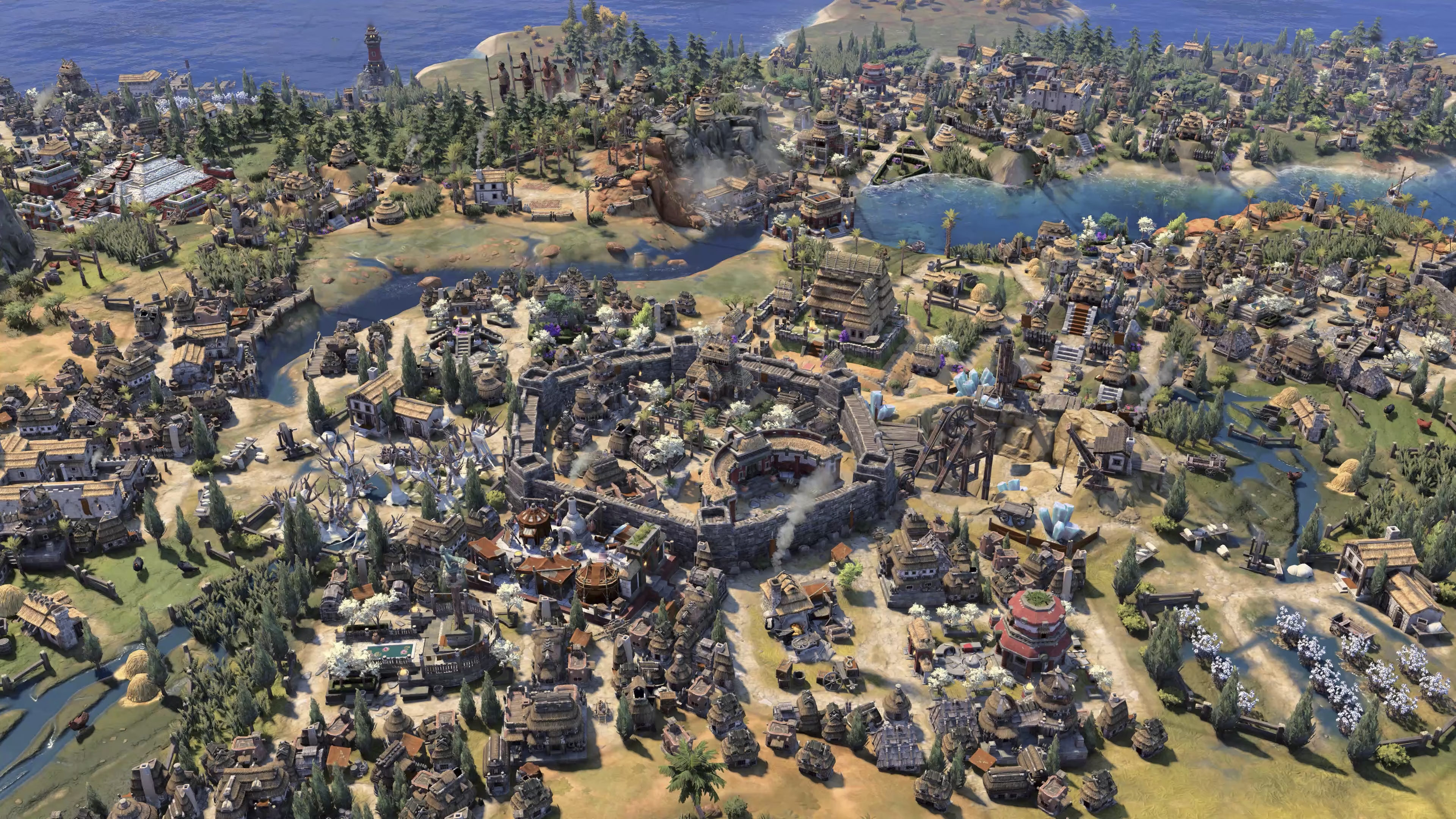
Age: Antiquity
Historical context: Arising some time around 800 CE, the Mississippian cultures built the largest pre-Columbian city we know of in what is now the United States at Cahokia, as well as most of the examples of monumental architecture from that region. They went into decline some time before European contact for what are still poorly-understood reasons.
- Attributes: Economic, Expansionist
- Unique ability: Goose Societies. All buildings produce bonus Food for each adjacent resource.
- Unique military unit: Burning Arrow. An archer with increased strength against fortified districts and siege units. Its attacks apply a burning status to the targeted tile that deals damage to units on the burning tile for a number of turns.
- Unique civilian unit: Watonathi. A merchant that gains bonus Gold for every resource you gain access to when it creates a trade route.
- Unique improvement: Potkop. Produces Gold, as well as bonus Food for every adjacent resource, and must be built on flat land.
Our advice: The Burning Arrow is a really interesting early game unit, letting you do some battlefield control that no one else has access to, which makes the Mississippians a really interesting pick for a militaristic playstyle. Otherwise, their ways to get bonus food will enable a lot of different playstyles.
Persia
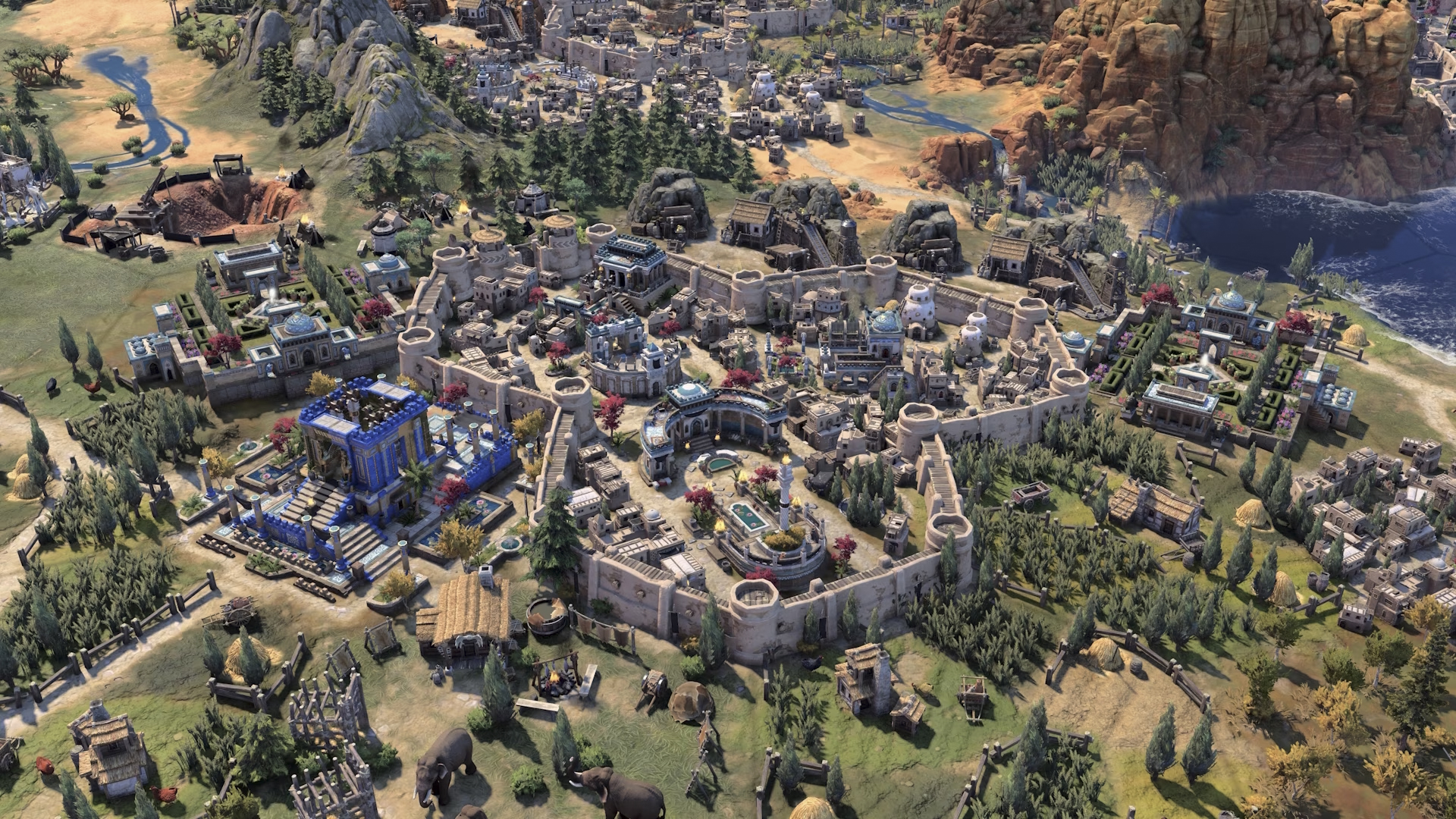
Age: Antiquity
Historical context: The Achaemenid Persian Empire was founded in 550 BCE and was one of the great powers of the ancient world. At its height, they controlled land from India all the way to modern Libya and had a complex system of local governors.
- Attributes: Economic, Militaristic
- Unique ability: Hamarana Council. Infantry units have increased combat strength when attacking.
- Unique military unit: Immortal. A melee infantry unit that heals for a small amount after defeating an enemy unit.
- Unique civilian unit: Hazarapatis. A replacement for the Commander that starts with the Initiative promotion, allowing your units to move after “unpacking” from a commander. (In Civ 7, Commanders basically scoop up all of your adjacent units onto its tile to make armies easier to move, but you can’t fight without unpacking them.)
- Unique improvement: Pairidaeza. Produces Culture and Gold, but cannot be built adjacent to one another.
Our advice: Being able to sustain a conquest with self-healing Immortals lends itself to being very aggressive very early. You always want to be going on the attack, even when defending. I haven’t played around with it yet, but I also think that having all your commanders start with Initiative is going to be huge. The Persians might be the best early warmonger civ.
Rome
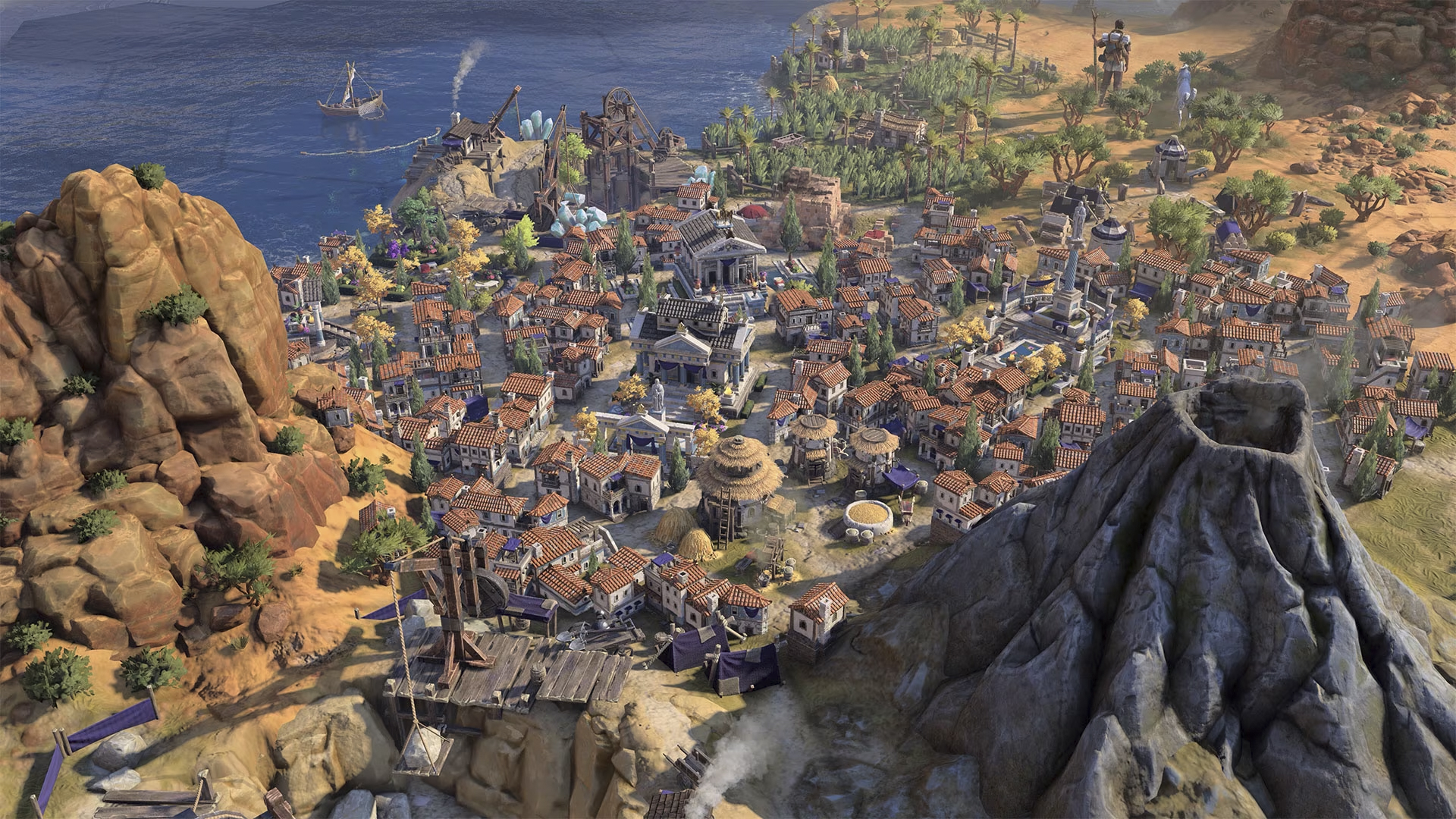
Age: Antiquity
Historical context: Come on, even FPS players know this one. They built some roads and aqueducts. They did some conquests with their legions. They did a lot of arguing in elaborate spaces, and eventually had their government overthrown by a dictator. We can probably learn from at least a couple of those things, even today.
- Attributes: Cultural, Militaristic.
- Unique ability: Twelve Tables. Bonus Culture on all districts in the Capital and in Towns. The notable thing here is that it does not apply to Cities that are not the Capital, which encourages building a single, super tall capital and keeping all your other settlements as Towns.
- Unique military unit: Legion. A melee infantry unit that gains increased strength for every Roman-specific tradition you have adopted into your Government.
- Unique civilian unit: Legatus. A Commander that is able to found new settlements after gaining enough promotions.
- Unique quarter: Forum. Produces Cultures, as well as bonus Gold for every Roman-specific tradition you have adopted into your Government.
- Unique building: Temple of Jupiter. Produces Happiness, as well as bonus Culture for adjacent Happiness-producing buildings.
- Unique building: Basilica. Produces Gold, as well as Influence for adjacent Culture buildings.
Our advice: Rome can certainly conquer, but they seem to be, perhaps, even better as a culture/settler rush civ this time around. The playstyle of all roads leading back to Rome with Towns serving as your outposts means you’ll need to be extra careful building and defending your capital for maximum imperium.
Abbasid
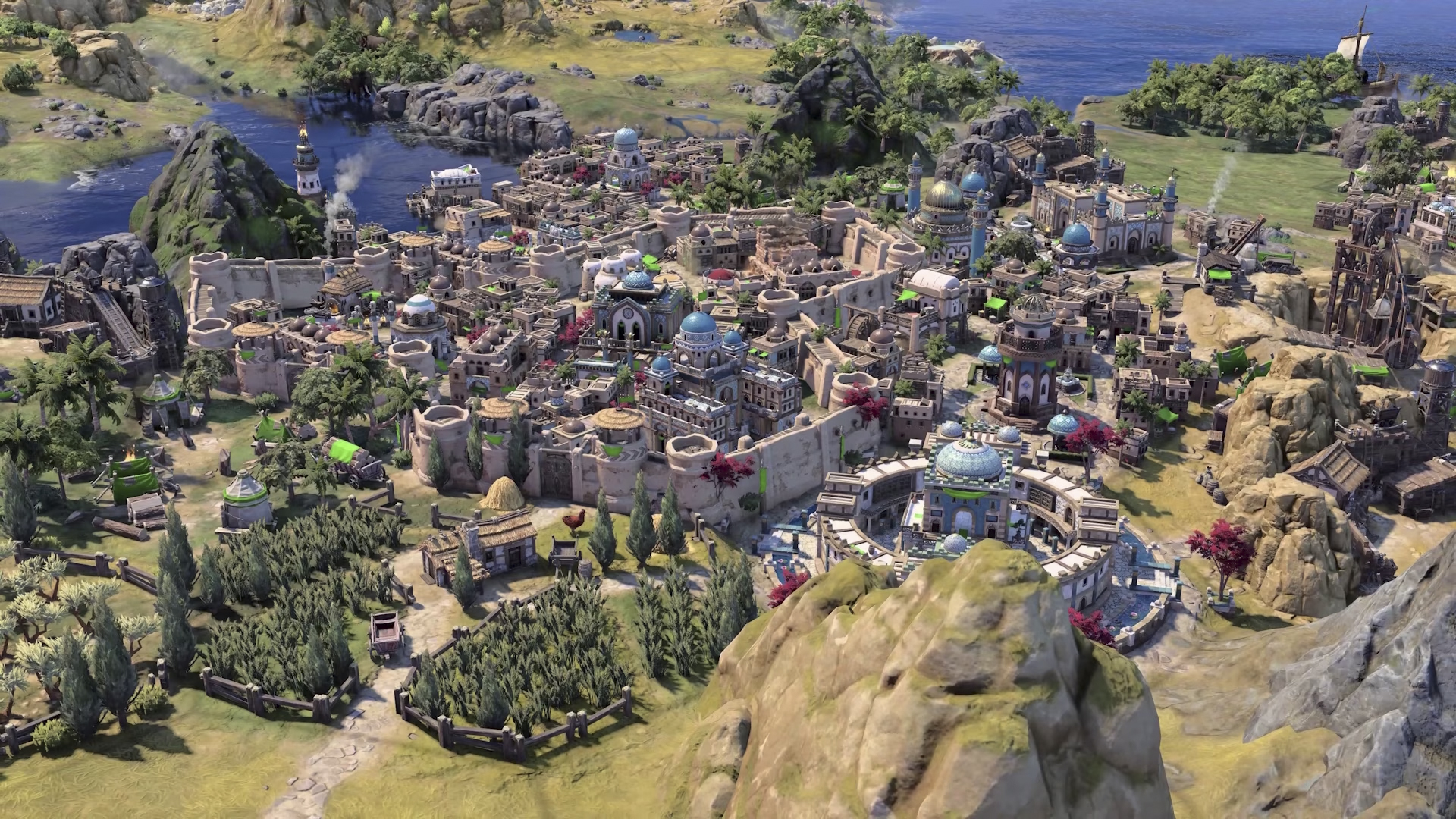
Age: Exploration
Historical context: The third Islamic Caliphate, established in 750 CE, they oversaw the flourishing of culture and science known as the Islamic Golden Age and ultimately repelled the Crusades. At their height, their territory stretched from Tunisia to modern Pakistan.
Attributes: Cultural, Scientific
- Unique ability: Medina. When a Specialist is created, you gain Gold for each population living in a rural district in that city.
- Unique military unit: Mamluk. A cavalry unit that gets increased combat strength for every population in urban districts when occupying a settlement.
- Unique civilian unit: Ālim. A unique Great Person created in a city with an Ulema, which can appear as one of several important figures from the Islamic Golden Age such as Ibn Sina and Ibn Fadlan.
- Unique quarter: Ulema. All specialists in the city where it’s built produce bonus Science.
- Unique building: Madrasa. Produces Science, with a bonus to Science for each adjacent quarter and Science building.
- Unique building: Mosque. Produces Happiness, with a bonus to Happiness for adjacent Culture buildings and bonus Culture for adjacent Happiness buildings. If you don’t already have the ability to do so, this will unlock the ability to found a Religion.
Our advice: The Abbasids may be the real Science powerhouse in Civ 7, with pretty decent bonuses to Gold and Culture as well. Mamluks are specialized for urban fighting, so you’ll not only want to urbanize your own settlements, but focus on attacking highly urbanized ones.
Chola
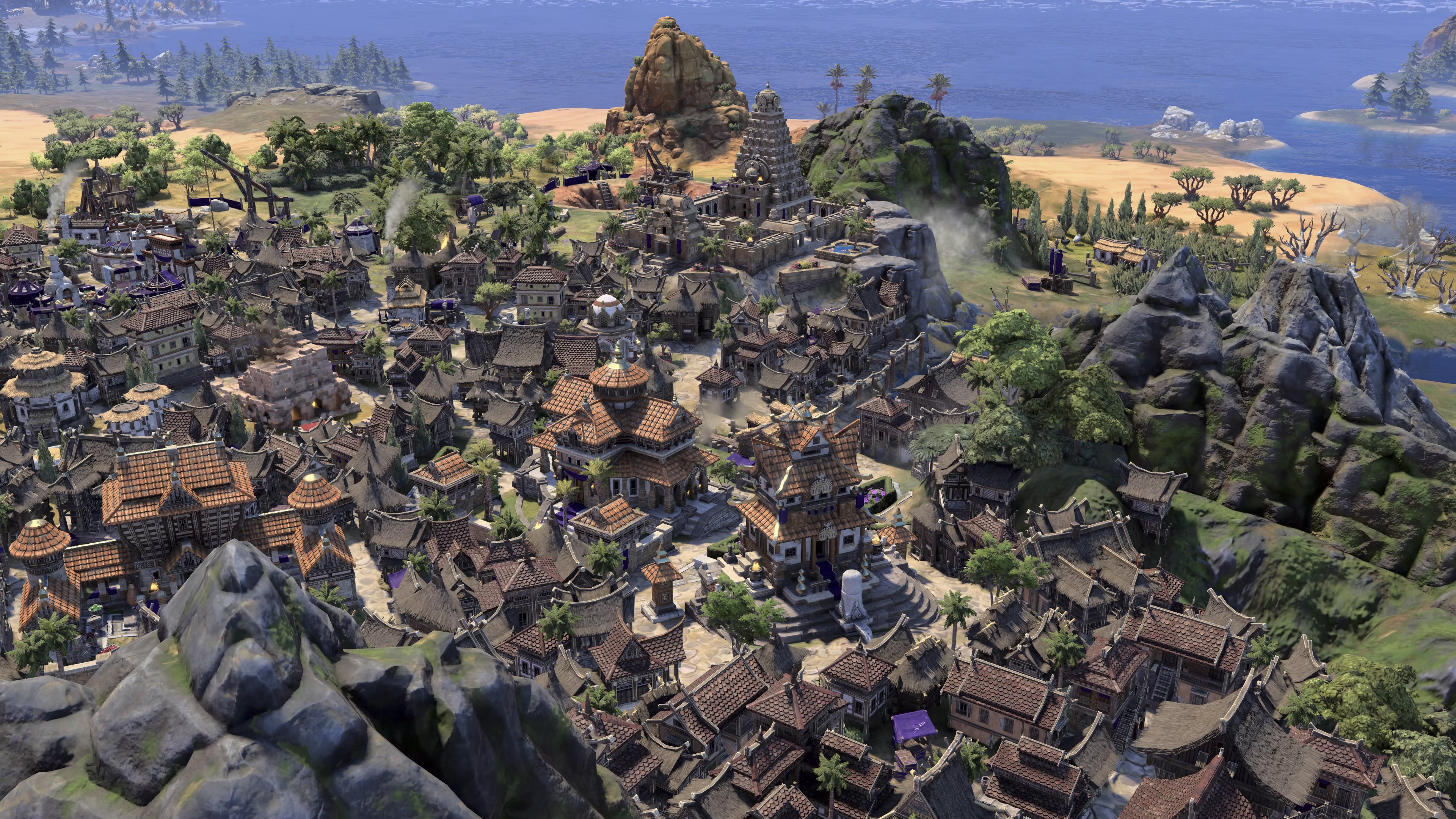
Age: Exploration
Historical context: A Tamil empire founded in Southern India in 848 CE, they came to command a large trade empire with bases as far away as modern Indonesia, and were influential in the spread of Hinduism into Southeast Asia.
- Attributes: Diplomatic, Economic
- Unique ability: Samayam. You get an extra trade route from every trade agreement.
- Unique military unit: Kalam. A naval unit that can attack twice per turn.
- Unique civilian unit: Ottru. A naval commander replacement that reduces the strength of all military units within its command radius.
- Unique quarter: Five Hundred Lords. Increases the range of your trade routes.
- Unique building: Manigramam. Produces Happiness, with a bonus to Happiness for each adjacent trade building and bonus gold for each adjacent quarter.
- Unique building: Anjuvannam. Produces Gold, with a bonus to Gold for adjacent coasts and navigable rivers, and a bonus to Production for naval units. Can only be built on the coast.
Our advice: Unsurprisingly, the Chola are highly specialized to be a maritime trade empire. In addition to supporting a formidable navy, the Ottru will also aid with coastal land battles. Beyond that, they aren’t particularly biased toward any specific victory objectives.
Hawaii
Age: Exploration
Historical context: While the Hawaiian islands may have been settled by Polynesians as early as the 100s CE, they were united into a single kingdom in 1795 by king Kamehameha. So far, very little has been announced about this civ beyond the name.
Majapahit
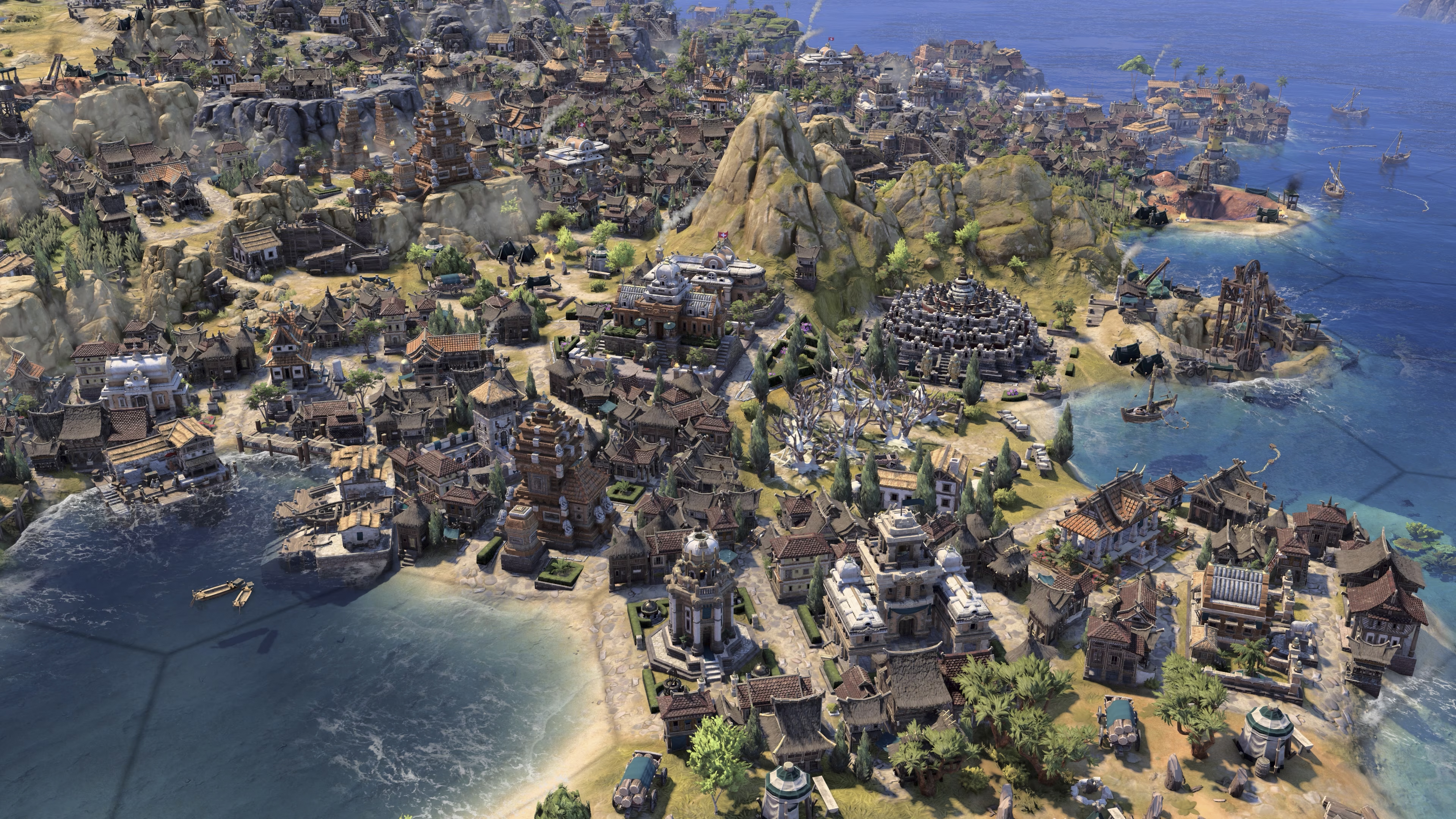
Age: Exploration
Historical context: A powerful Hindu kingdom that existed in modern-day Indonesia from the late 1200s through the early 1500s. Its rise to power saw it allying with and then betraying Kublai Khan’s forces when they invaded Java in 1293.
- Attributes: Economic, Cultural
- Unique ability: Negara. All Cities except the Capital have an increased Specialist Limit. After the Exploration Age, the Specialist Limit increase goes away, and the Specialists become inactive until you increase the Specialist Limit.
- Unique Quarter: Pura. Receive a Relic when completed.
- Unique Building: Candi Bentar. Receive a Culture Adjacency for Coast and Navigable River tiles.
- Unique Building: Meru. Ageless. Receive a Happiness Adjacency for Mountains and Wonders. Increased Happiness on Natural Wonder tiles.
- Unique civilian unit: Pedanda. Unique Missionary Unit. Receive Culture when you convert a Settlement to your Religion. Requires a Temple.
- Unique military unit: Cetbang. Unique Naval Unit. Has increased Combat Strength against Naval Units. Can pillage tiles at range with a reduced Movement cost.
- Associated Wonder: Borobudur. Adds Happiness. Increase Happiness on Quarters. Must be built adjacent to a Coast tile.
Ming China
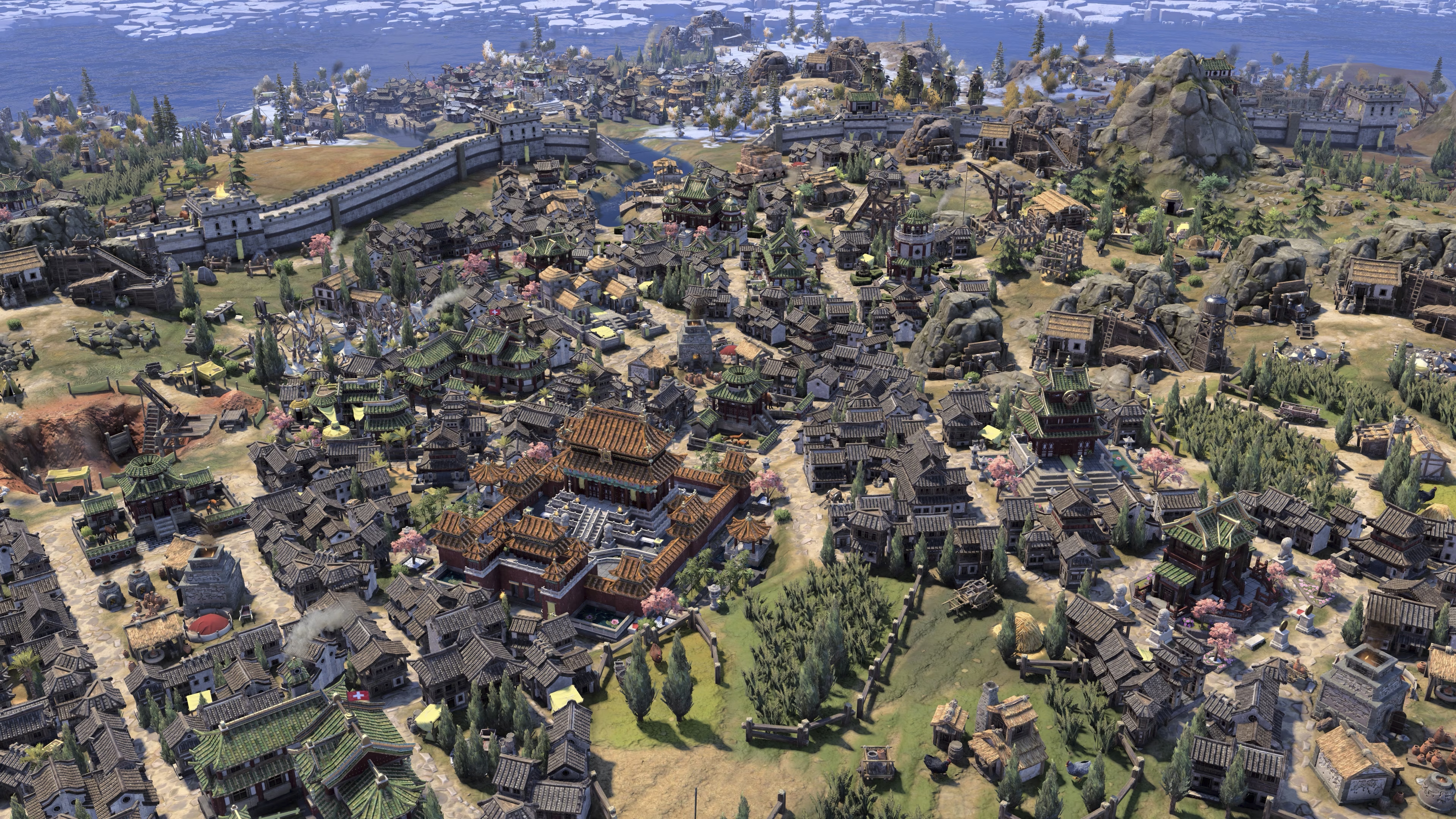
Age: Exploration
Historical context: Established in 1368, the Ming dynasty restored Chinese rule to China after a period of Mongol domination under the Yuan, founded by Genghis Khan and his successors. They were responsible for expanding the Great Wall of China into what we know it as today.
- Attributes: Economic, Scientific
- Unique ability: Great Canon of Yongle. You gain increased Science in the capital, but decreased Science per turn for every social policy you have added to your government.
- Unique military unit: Xunleichong. A melee infantry unit that also has a ranged attack, they gain bonus strength in flat terrain with no vegetation.
- Unique civilian unit: Mandarin. A replacement for the Merchant that gives you a large amount of Gold every time you build a road.
- Unique improvement: Ming Great Wall. Like the Han equivalent, it can only be built in a single, continuous line. Produces Gold for every adjacent fortification (including other Great Wall segments).
Our advice: The Ming still excel in Science, but things get a bit trickier due to the social policy restriction. It’s sort of an interesting way to model their later decline. Luckily, their focus on Gold should make up for this, or allow you to pivot to a different strategy entirely.
Mongolia
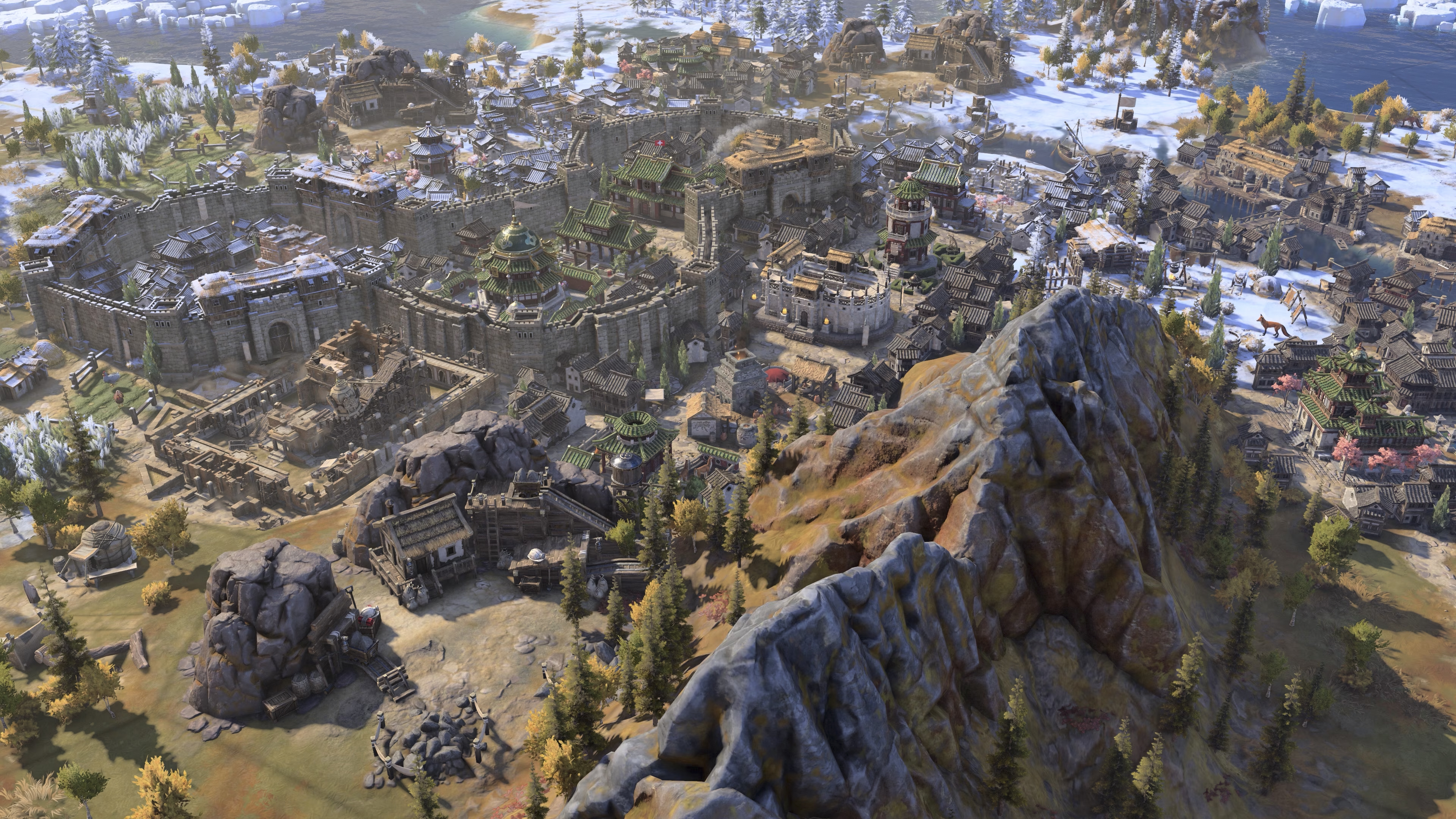
Age: Exploration
Historical context: Under Genghis Khan and his heirs in the 1200s, the Mongol Empire created a vast confederation of steppe people across Eurasia that controlled the largest land empire, by area, in history. They ruled all the way from Southern China to parts of modern Turkey and Romania.
- Attributes: Expansionist, Militaristic
- Unique ability: Bokh. When capturing a settlement, you get a copy of the strongest cavalry unit you can currently build. However, you have -50% production toward Settlers. You also gain victory points for the conquest victory objective differently from other civs.
- Unique military unit: Keshig. A ranged cavalry unit with increased movement that heals after defeating enemies.
- Unique civilian unit: Noyan. A Commander replacement with increased movement, it grants improved Flanking ability to cavalry units.
- Unique improvement: Ortöö. Produces Gold, and resets the movement allowance for any unit that lands on it. Can’t be placed on rough terrain, vegetation, or rivers.
Our advice: Hoo boy. This is gonna be fun. As you’d expect, the Mongolians are honed for fast conquests and controlling large land areas. Sustaining assaults with Keshigs will be trivial if you know what you’re doing, but remember that they’re probably not sufficient on their own to win sieges. Creating networks of ortöös will allow you to move startlingly fast across the open plains, but rocky, coastal areas, forests, and rivers will present strategic obstacles.
Norman
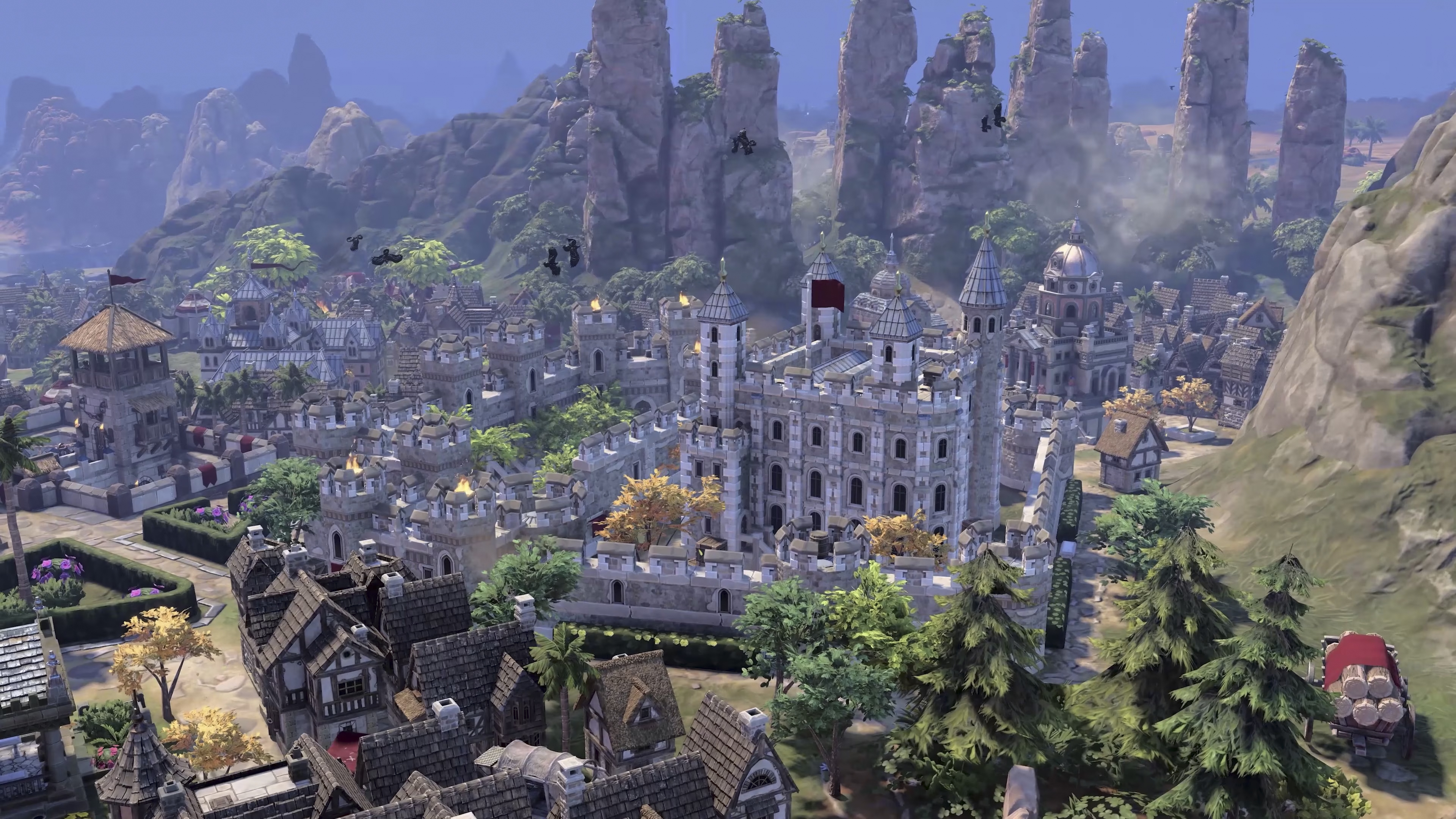
Age: Exploration
Historical context: In 1066, William the Bastard and a bunch of his bandit friends crossed the channel to seize the Kingdom of England on a dubious claim and make our eventual language of global communication way more complicated than it needed to be.
- Attributes: Diplomatic, Militaristic
- Unique ability: Normannitas. Land units get +1 movement when embarked, and +5 strength when adjacent to a coast.
- Unique military unit: Chevaler. A cavalry unit with increased strength against any unit that has less movement speed.
- Unique civilian unit: Sokeman. A Settler replacement that automatically builds a wall when a new town is created.
- Unique quarter: Donjon. Creates a Chevaler for free when built.
- Unique building: Motte. Produces Happiness if built on rough terrain, and functions as a fortification.
- Unique building: Bailey. Produces Culture for adjacent walls, and functions as a fortification.
Our advice: Castles. That’s it, that’s the post. The Normans excel at protecting their outposts and building up defensive infrastructure, while also enjoying some residual benefits to amphibious warfare from their viking—with a lower-case v because it’s a job and not an ethnicity but I realize I may have lost that battle for good—roots. They don’t really excel at anything besides warfare though, just like William and his pack of pillagers.
Shawnee
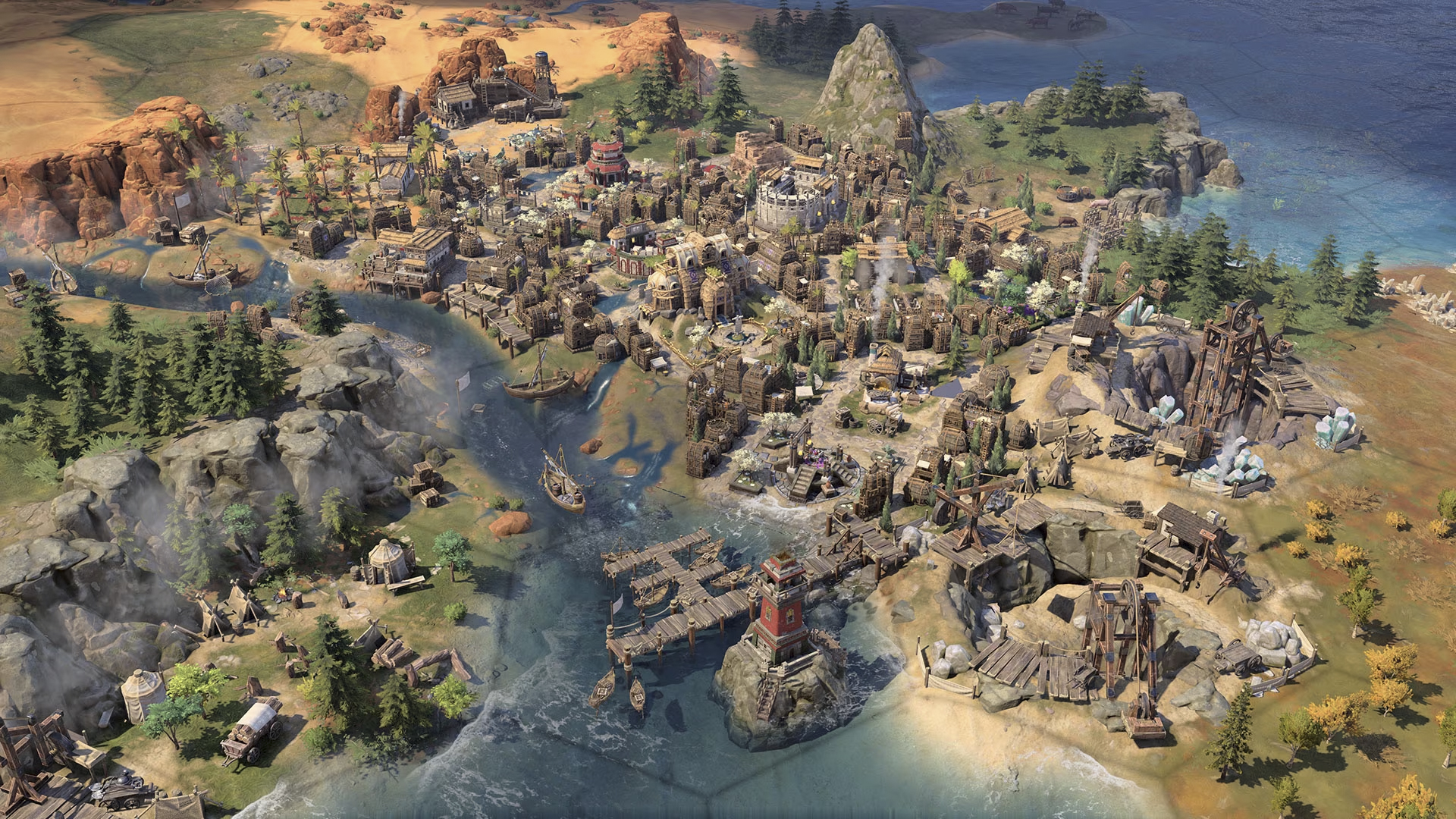
Age: Exploration
Historical context: A North American people originally from what is now Ohio, and the namesake of the town where this author went to high school, they formed the core of a great confederacy that represented one of the most concerted Native efforts to curb US Westward expansion, under their chief Tecumseh.
- Attributes: Diplomatic, Economic.
- Unique ability: Nepekifaki. Settlements next to navigable rivers produce more Food on river tiles, but settlements that are not next to a navigable river produce less.
- Unique military unit: Kispoko Nena’to. A melee infantry unit with increased strength for every Empire Resource you possess. (The currently known Empire Resources include Gold, Iron, Ivory, Marble, and Wine.)
- Unique civilian unit: Hoceepkileni. A Missionary replacement that has increased movement, and that can cross rivers without ending its movement.
- Unique improvement: Mawaskawe Skote. Produces food, as well as bonus Gold for every adjacent resource. Can only be placed on tiles with vegetation, and not adjacent to another Mawaskawe Skote.
Our advice: This is another one of those river valley boom civs, with the added twist that you can have a very deadly army if you manage to accumulate a lot of resources through expansion and trade. They aren’t particularly biased toward any specific victory type.
Songhai
Age: Exploration
Historical context: Founded in the 1430s, the Songhai Empire conquered much of inland West Africa, with its center in what is today the country of Mali. They were influential in the spread of Islam to sub-Saharan Africa.
- Attributes: Economic, Militaristic
- Unique ability: Tarikh al-Sudan. +15 trade route range for cities on navigable rivers. Trade ships can’t be plundered while sailing on navigable rivers.
- Unique military unit: Gold Bangles Infantry. (Stats not yet shown.)
- Unique civilian unit: Tajiro. (Stats not yet shown.)
- Unique infrastructure: Caravansarai. (Stats not yet shown.)
Our advice: We don’t have the full picture of Songhai yet, but they seem tooled to be a strong inland trade civ, with the ability to secure routes overland and via rivers. Judging by their attributes and their historical reputation, they will also likely turn out to be a strong military civ.
Spain
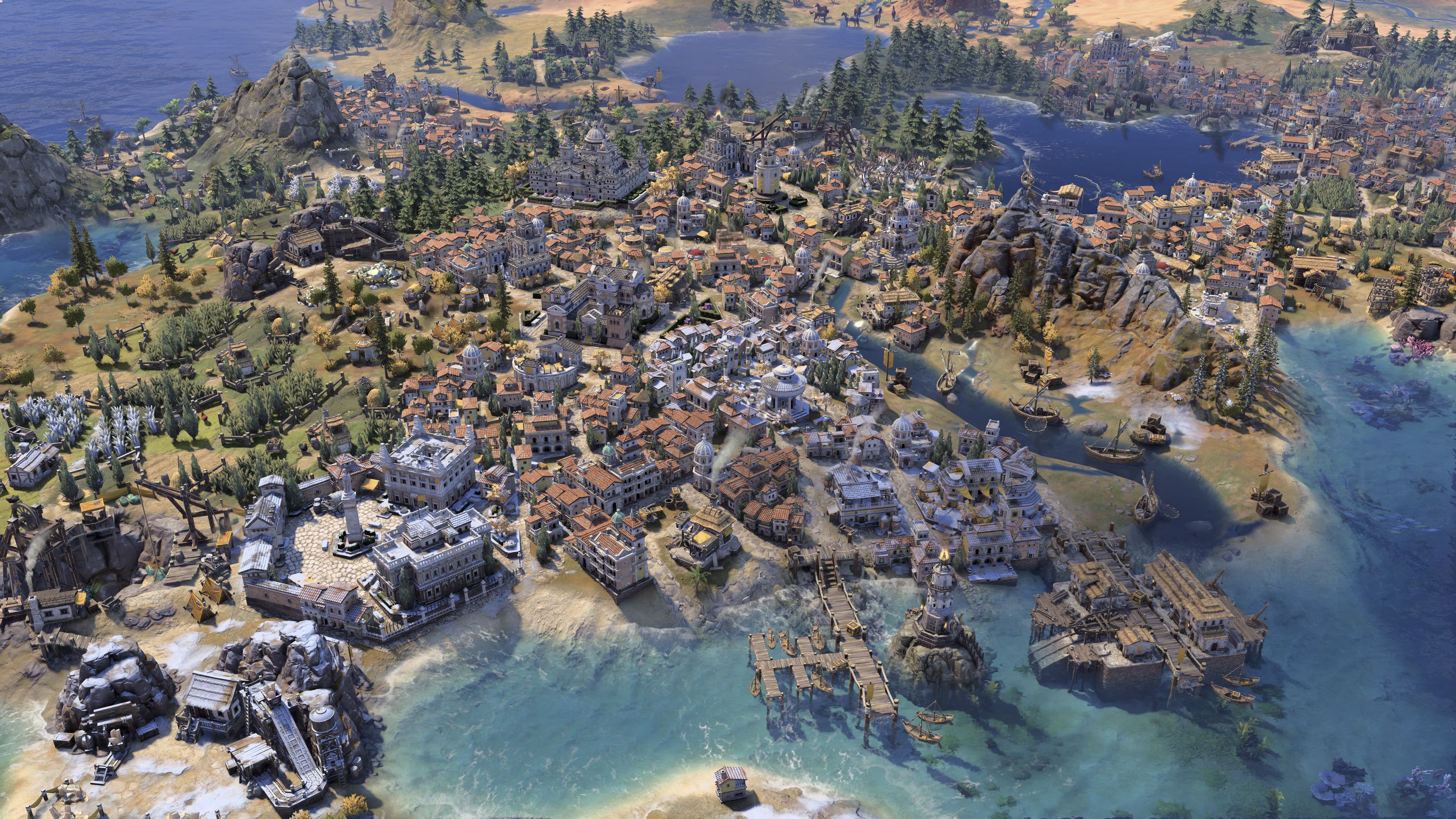
Age: Exploration
Historical context: This civ represents the Spanish Empire as it existed from 1492 onwards. At the forefront of the European Age of Discovery, it came to control territory from modern-day Canada all the way down to Chile and Argentina, supported by influential religious missions and a powerful armada.
- Attributes: Expansionist, Militaristic
- Unique ability: Sigio de Oro. You get a 15% discount on converting a Town into a City, increasing to 30% if that town is considered part of the “Distant Lands.”
- Unique military unit: Tercio. An infantry unit that has increased strength, and grants any adjacent units an additional +3 strength against cavalry (not stackable).
- Unique civilian unit: Conquistador. Another unique type of Great Person, which can appear as a number of significant figures from the Age of Exploration such as Christopher Columbus or Hernán Cortés. They each have a unique ability that can only be activated in “Distant Lands” (far from your starting Homelands), and start with the ability to cross ocean tiles.
- Unique quarter: Plaza. Produces bonus gold in the settlement where it’s built for every settlement you own in Distant Lands.
- Unique building: Casa Consistorial. +5 Culture, and an additional +1 for every adjacent quarter and wonder. Can only be built in your Homelands next to a coast.
- Unique building: Casa de Contratación. +5 Gold, and an additional +1 for adjacent navigable rivers, resources, and wonders. Can only be built in your Homelands.
Our advice: If you guessed the Spanish would be focused on exploration and overseas colonization, you would have guessed right. They will benefit greatly from settling tons of towns and cities in places distant to their capital, and should have a fairly easy time doing so. Culture seems to be their forte, but with all that imperial Gold coming in, you can probably go for any strategy you want.
Modern Age civs
We haven’t seen much about the Modern Age civs yet other than their names, but here’s a little bit of historical context for each.
- Buganda: The Baganda people of modern Uganda (I know, this is a lot of similar-sounding proper nouns—the people are Baganda, the kingdom is Buganda, and the modern state is Uganda) unified under a single king in the 1200s, and it retains the status of a traditional kingdom under the Ugandan state to this day. They were one of the most powerful states in East Africa from the 1700s up until they were eventually colonized by the British in 1884.
- France: This civ is based on the First French Empire, ruled by Napoleon Bonaparte. It only lasted for about three years, but in that time, managed to conquer the lion’s share of continental Europe before succumbing to a coalition of a bunch of other nations who didn’t like that very much.
- Japan: This civ represents the Japanese Empire, which lasted from the Meiji Restoration of 1868 up until their defeat in World War II in 1945. It was a time of great nationalism, expansionism, and militarism. So, like the French, I think we can expect them to have a pretty aggressive playstyle.
- Mexico: Mexico gained its independence from Spain in 1821, at the time controlling most of Central America and much of what is now the Western and Southwestern United States. This civ is simply described as representing the “modern nation,” rather than any specific historical government like the French and Japanese civs.
- Mughal Empire: A little bit of a stretch for the label of “Modern,” the Mughal Empire existed from 1526 until it was finally absorbed into the British Raj in 1867. At its height, it controlled nearly all of modern India, Pakistan, Bangladesh, and even parts of Afghanistan. They had a very effective military for the time, so this will probably be yet another aggressive modern civ.
Since any of these civs can be played with any leader, be sure to also check out our Civilization 7 Leaders guide to start planning how you’ll mix and match your way to global pre-eminence.






